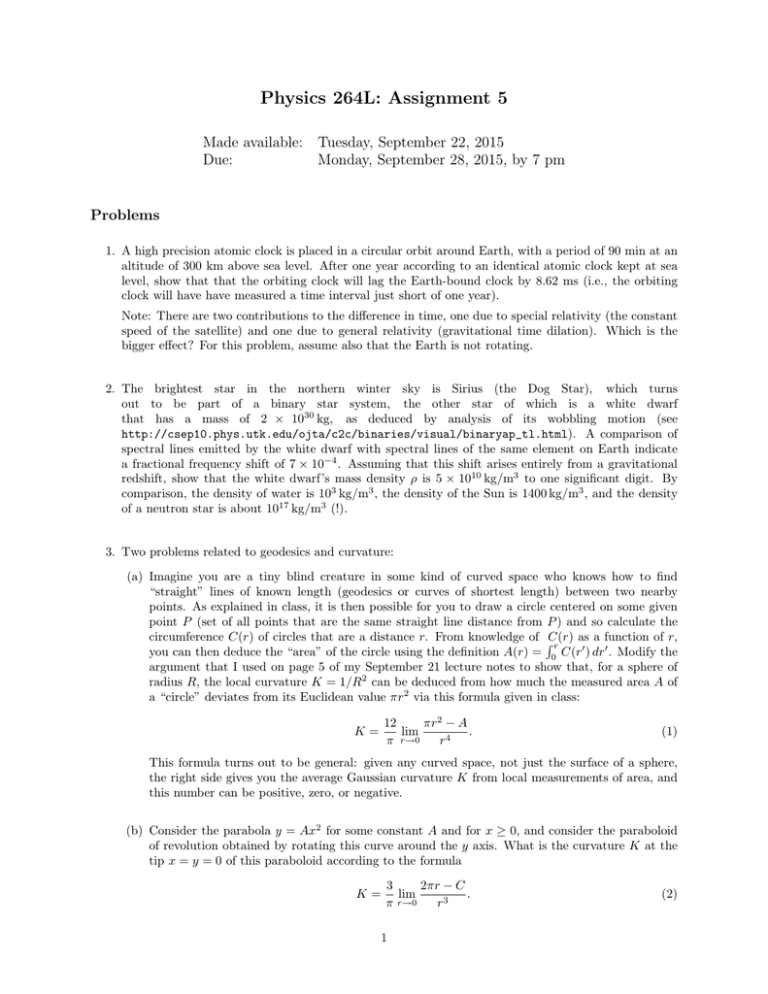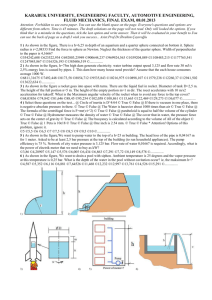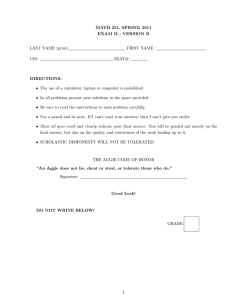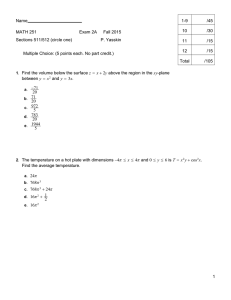Physics 264L: Assignment 5 Made available: Tuesday, September 22, 2015 Due:
advertisement

Physics 264L: Assignment 5 Made available: Tuesday, September 22, 2015 Due: Monday, September 28, 2015, by 7 pm Problems 1. A high precision atomic clock is placed in a circular orbit around Earth, with a period of 90 min at an altitude of 300 km above sea level. After one year according to an identical atomic clock kept at sea level, show that that the orbiting clock will lag the Earth-bound clock by 8.62 ms (i.e., the orbiting clock will have have measured a time interval just short of one year). Note: There are two contributions to the difference in time, one due to special relativity (the constant speed of the satellite) and one due to general relativity (gravitational time dilation). Which is the bigger effect? For this problem, assume also that the Earth is not rotating. 2. The brightest star in the northern winter sky is Sirius (the Dog Star), which turns out to be part of a binary star system, the other star of which is a white dwarf that has a mass of 2 × 1030 kg, as deduced by analysis of its wobbling motion (see http://csep10.phys.utk.edu/ojta/c2c/binaries/visual/binaryap_tl.html). A comparison of spectral lines emitted by the white dwarf with spectral lines of the same element on Earth indicate a fractional frequency shift of 7 × 10−4 . Assuming that this shift arises entirely from a gravitational redshift, show that the white dwarf’s mass density ρ is 5 × 1010 kg/m3 to one significant digit. By comparison, the density of water is 103 kg/m3 , the density of the Sun is 1400 kg/m3 , and the density of a neutron star is about 1017 kg/m3 (!). 3. Two problems related to geodesics and curvature: (a) Imagine you are a tiny blind creature in some kind of curved space who knows how to find “straight” lines of known length (geodesics or curves of shortest length) between two nearby points. As explained in class, it is then possible for you to draw a circle centered on some given point P (set of all points that are the same straight line distance from P ) and so calculate the circumference C(r) of circles that are a distance r. From knowledge of RC(r) as a function of r, r you can then deduce the “area” of the circle using the definition A(r) = 0 C(r′ ) dr′ . Modify the argument that I used on page 5 of my September 21 lecture notes to show that, for a sphere of radius R, the local curvature K = 1/R2 can be deduced from how much the measured area A of a “circle” deviates from its Euclidean value πr2 via this formula given in class: πr2 − A 12 . lim π r→0 r4 K= (1) This formula turns out to be general: given any curved space, not just the surface of a sphere, the right side gives you the average Gaussian curvature K from local measurements of area, and this number can be positive, zero, or negative. (b) Consider the parabola y = Ax2 for some constant A and for x ≥ 0, and consider the paraboloid of revolution obtained by rotating this curve around the y axis. What is the curvature K at the tip x = y = 0 of this paraboloid according to the formula K= 2πr − C 3 lim . π r→0 r3 1 (2) Note: you can get the “radial” distance r from the tip of the paraboloid to some other point on the paraboloid by looking up in your calculus book how to calculate the arc length of a curve defined by a function y = f (x): Z bp 1 + f ′ (x)2 dx. (3) L= a A hint for this problem is to expand the integrand in Eq. (3) using the generalized binomial theorem before carrying out the integral. More specifically, because of Eq. (2), we are only interested in the limit r is tiny, so in Eq. (3) applied to the function y = Ax2 to get the geodesic radius r Z x ¡ ¢1/2 ′ 1 + 4A2 (x′ )2 dx , (4) r= 0 we can assume that r is tiny, so x must be tiny, which means that the dummy variable x′ in the integral is always tiny (since 0 ≤ x′ ≤ x), which means that 4A2 x2 is always tiny, which means you can apply the binomial theorem to simplify the integrand which in turn makes the integral easy. 4. Somewhat surprisingly, a black hole does not have to have a large mass density ρ. Define the volume Vs of a black hole to be VS = (4/3)πRS3 where Rs is its Schartzschild radius Rs . (This is not a correct formula for the volume enclosed since space is curved but it gives us the order-of-magnitude.) In units of the mass of the Sun, for what mass M will the mass density of the black hole M/V equal that of water, 103 kg/m3 ? Compare your answer with the mass density of the giant black hole at the center of our galaxy, the Milky Way. 5. Problem 16.2 on page 676 of Chapter 16 of the Carroll-Ostlie astrophysics text, first edition. Explain also why this makes sense by thinking about the gravitational mass E/c2 of a photon. 6. Problem 16.5 on pages 676-677 of the Carroll-Ostlie Chapter 16. 7. To the nearest integer, please give the time in hours that it took you to complete this assignment, including reading in the text. Also, if you got help with this assignment, please give the names of the people from whom you got help (classmates, the TA, myself, etc). 8. Optional Challenge Problems (a) Challenge 5.1 Assuming that the Earth is a perfect sphere with a solid surface, at which points P on the surface can a person walk one kilometer south, walk one kilometer east, and walk one kilometer north and end up exactly back at P ? Hint: there is more than one such location. Note: Because of the Earth’s rotation, the shape of the Earth’s surface deviates slightly from a sphere and is a so-called oblate spheroid. (b) Challenge 5.2: A thin string is wound symmetrically about a cylindrical rod of length 12 cm and with circumference 4 cm such that it wraps around exactly 4 times from end to end, like this: 2 Using just junior high school math (no calculus, no trigonometry), determine the length of the string. (c) Challenge 5.3: What is the largest possible radius of a circle that is contained within a 4dimensional hypercube whose side has length 1? 3





